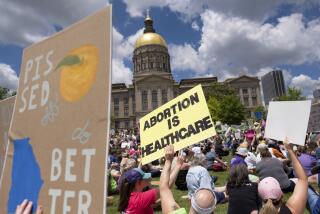A Muddled Ruling--There They Go Again : Court upholds most of Pennsylvania abortion law
- Share via
Those opposed to abortion hoped, and those who support abortion rights feared, that Pennsylvania’s abortion law would finally provide the vehicle for the Supreme Court’s conservative majority to categorically overturn a woman’s right to terminate an unwanted pregnancy. That a bare 5-4 majority, fractured and muddled, did not do so is no cause for relief, even if it could have the effect of making it harder for states to enact even more restrictive abortion laws. Monday’s long-awaited ruling in Casey vs. Planned Parenthood, poorly crafted as it is, unmistakably limits the rights of all women.
POOR LAW: Despite the majority’s assertions to the contrary, the absolute constitutional right to an abortion during the first trimester of pregnancy, as defined by 1973’s Roe vs. Wade decision, is now dead law. An emerging centrist group of Justices Sandra Day O’Connor, Anthony M. Kennedy and David H. Souter, joined in part by Harry A. Blackmun and John Paul Stevens, said that “the essential holding of Roe vs. Wade should be retained and once again reaffirmed.” But the court nonetheless upheld all but one of the restrictions that Pennsylvania sought to impose. That undermines the majority’s language in Casey about the sanctity of Roe’s absolute guarantees.
In place of Roe’s absolute guarantees, the court has defined a new test by which it will decide whether the state’s “legitimate interests” in “protecting the life of the fetus” collide with a woman’s right of choice. Restrictions that impose “an undue burden” on a woman’s ability to choose abortion will not stand. But the majority held that these Pennsylvania requirements are constitutional: that a woman be told about fetal development and alternatives to abortion; that she wait at least 24 hours after this explanation; that unmarried girls under age 18 obtain consent from their parents--or a judge; that doctors keep detailed records of each abortion, subject to public disclosure. The court struck down only a requirement that married women inform their husbands beforehand.
The court did not define which other restrictions would pose an “undue burden” and which would not. This ruling instead, in effect, invites states to test each new set of restrictions. Abortion rights have stronger protections in California, which has a constitutional right to privacy and has a Legislature and governor currently supportive of abortion rights. But in the absence of clear guidance from the high court, the divisive abortion issue is now more unsettled and dependent on state boundaries than ever.
POOR OUTCOME: Casey follows directly from decisions in 1989 allowing states to ban public funds for abortion and prohibit the procedure at public facilities, and from a 1991 decision barring federally funded clinics from even discussing abortion with pregnant patients. Taken together, the effect of these decisions is profoundly restrictive for women.
Already, poor, uninformed women and those women who live far from an abortion clinic have diminished access to a legal abortion.
Now in Pennsylvania, even women able to afford the procedure and find a physician willing to perform it cannot proceed without interference. Pennsylvania’s law is patently designed to discourage a woman from having an abortion, to make her feel shame and to subject her and her physician to harassment by making their names subject to public disclosure. In this light, the court’s assertion of a “realm of personal liberty which the government may not enter” becomes almost meaningless.
More to Read
Get the L.A. Times Politics newsletter
Deeply reported insights into legislation, politics and policy from Sacramento, Washington and beyond. In your inbox twice per week.
You may occasionally receive promotional content from the Los Angeles Times.








